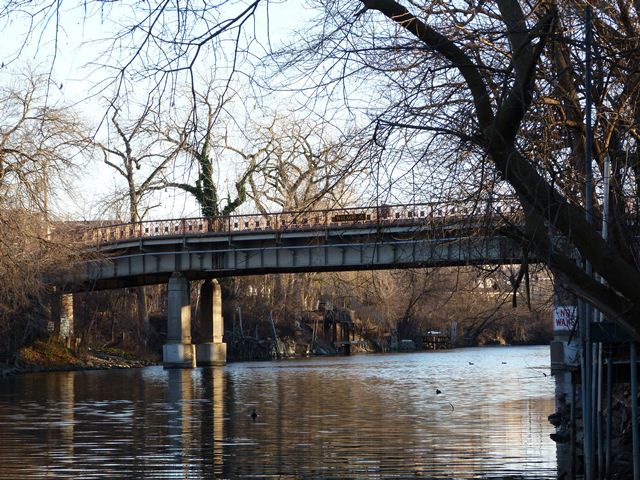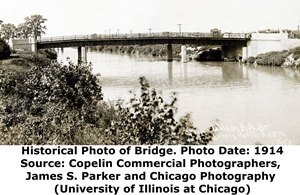We Recommend:
Bach Steel - Experts at historic truss bridge restoration.
BridgeHunter.com Phase 1 is released to the public! - Visit Now
Wilson Avenue Bridge

Primary Photographer(s): Nathan Holth
Bridge Documented: June 1, 2009 and December 12, 2012
Chicago: Cook County, Illinois: United States
1913 By Builder/Contractor: Nash-Dowdle Company of Chicago, Illinois
1993
99.4 Feet (30.3 Meters)
210.0 Feet (64 Meters)
25.3 Feet (7.71 Meters)
3 Main Span(s)
16609327314

View Information About HSR Ratings
Bridge Documentation
View Archived National Bridge Inventory Report - Has Additional Details and Evaluation
About This Bridge
This bridge is a noteworthy example of a highway over water stationary plate girder in the Chicago area with noteworthy design and aesthetic details. There are a few remaining plate girder highway bridges on the North Shore Channel of varying design. Among those, this bridge is a well-preserved example of a deck plate girder bridge. It retains original decorative railings. The bridge is also historically significant as a structure associated with the North Shore Channel, a very important part of Chicago's rich heritage of controlling water and rivers.
The bridge has a substantial skew. More noteworthy is its early use of a cantilevered beam design where the end spans cantilever out beyond the piers to support a suspended span positioned in the center between the two piers. The use of cantilevered beams and suspended spans (sometimes with a pin and hanger detail) in girder and stringer bridges was more common in the mid 20th Century, and so this 1913 example stands out as unusual. There is a reason for this, and its a rather bizarre one. Although this was designed as a fixed bridge (not movable) city engineers wanted the ability to provide additional clearance in the rare chance that for some out-of-the-ordinary reason a large boat needed to get down the waterway, such as boats for dredging or pile driving. The design was intended to make it possible to lift out the center suspended span on scows to provide a 60 foot wide opening for the boat to pass through. Along with another similar bridge that was built at the same time on Irving Park Boulevard, this is probably one of the only bridges that was specifically designed to have a whole section of it temporarily removed if needed.
The bridge's decorative railings and aesthetic considerations on the substructure were thanks to the involvement of the Chicago Plan Commission in the design of this bridge. The Chicago Plan Commission took interest in the design of the bridge because of its location in an upscale residential area.
John Dowdle Biography
Source: Prominent Democrats of Illinois: a brief history of the rise and progress of the Democratic party of Illinois, 1899.
Was born in Manchester, England, December 24, 1853, and is the son of P. H. Dowdle and Anna Dowdle. Upon the death of P. H. Dowdle, which occurred when the subject of this sketch was but five years of age, the
widowed mother removed from Ireland to the United States, locating in Chicago, bringing her son John with her and leaving behind with her parents two younger brothers. After settling in Chicago young Dowdle was educated in the public
schools, leaving which he entered the employ of T. S. Phillips, as errand boy, dealers in tailors' trimmings, located on Lake street, where he remained about two years. Leaving his position he sought and secured employment with the
McCormick Reaper Company, on the North Side, where he remained for some time. In 1868 Mr. Dowdle apprenticed himself as a stone cutter and served 'his time, following this vocation until 1886, when he, with two other gentlemen, formed a
cut stone contracting company under the firm name of Robinson, Dowdle & McWhirter, which firm continued in active business for two years, when Mr. Robinson retired and the firm was known as Dowdle & McWhirter. Losing heavily by the
failure of the Park National Bank, July 2, 1890, in which the firm was a stockholder, they were compelled to make an assignment, and within two years the obligations of the firm of Dowdle & McWhirter were liquidated, and Mr. Dowdle
formed a partnership with his father-in-law, Mr. Thomas Nash, as general contractors, known as the firm of Nash & Dowdle, of which firm he is still a member.
Mr. Dowdle is a member of the National Union Total Abstinence Society, Cook
County Democracy and Monticello Club. In religion Mr. Dowdle is a Roman Catholic. He was married December 29, 1887, to Miss Margaret Nash. They have four children, one daughter and three sons.
![]()
Historic Bridges of Chicago and Cook County


Chicago and Cook County are home to one of the largest collections of historic bridges in the country, and no other city in the world has more movable bridges. HistoricBridges.org is proud to offer the most extensive coverage of historic Chicago bridges on the Internet.
General Chicago / Cook County Bridge Resources
Chicago's Bridges - By Nathan Holth, author of HistoricBridges.org, this book provides a discussion of the history of Chicago's movable bridges, and includes a virtual tour discussing all movable bridges remaining in Chicago today. Despite this broad coverage, the book is presented in a compact format that is easy to take with you and carry around for reference on a visit to Chicago. The book includes dozens of full color photos. Only $9.95 U.S! ($11.95 Canadian). Order on Amazon.
Chicago River Bridges - By Patrick T. McBriarty, this is a great companion to Holth's book shown above. This much larger book offers an extremely in-depth exploration of Chicago's movable highway bridges, including many crossings that have not existed for many years. Order Now Direct From The Publisher! or order on Amazon.
View Historic American Engineering Record (HAER) Overview of Chicago Bascule Bridges (HAER Data Pages, PDF)
Chicago Loop Bridges - Chicago Loop Bridges is another website on the Internet that is a great companion to the HistoricBridges.org coverage of the 18 movable bridges within the Chicago Loop. This website includes additional information such as connections to popular culture, overview discussions and essays about Chicago's movable bridges, additional videos, and current news and events relating to the bridges.
Additional Online Articles and Resources - This page is a large gathering of interesting articles and resources that HistoricBridges.org has uncovered during research, but which were not specific to a particular bridge listing.
![]()
Photo Galleries and Videos: Wilson Avenue Bridge
Bridge Photo-Documentation
Original / Full Size PhotosA collection of overview and detail photos. This gallery offers photos in the highest available resolution and file size in a touch-friendly popup viewer.
Alternatively, Browse Without Using Viewer
![]()
Bridge Photo-Documentation
Mobile Optimized PhotosA collection of overview and detail photos. This gallery features data-friendly, fast-loading photos in a touch-friendly popup viewer.
Alternatively, Browse Without Using Viewer
![]()
Maps and Links: Wilson Avenue Bridge
Coordinates (Latitude, Longitude):
Search For Additional Bridge Listings:
Bridgehunter.com: View listed bridges within 0.5 miles (0.8 kilometers) of this bridge.
Bridgehunter.com: View listed bridges within 10 miles (16 kilometers) of this bridge.
Additional Maps:
Google Streetview (If Available)
GeoHack (Additional Links and Coordinates)
Apple Maps (Via DuckDuckGo Search)
Apple Maps (Apple devices only)
Android: Open Location In Your Map or GPS App
Flickr Gallery (Find Nearby Photos)
Wikimedia Commons (Find Nearby Photos)
Directions Via Sygic For Android
Directions Via Sygic For iOS and Android Dolphin Browser
USGS National Map (United States Only)
Historical USGS Topo Maps (United States Only)
Historic Aerials (United States Only)
CalTopo Maps (United States Only)



